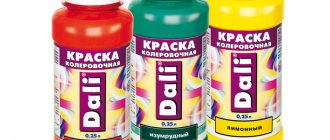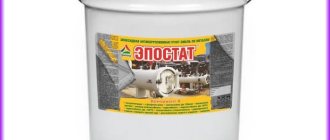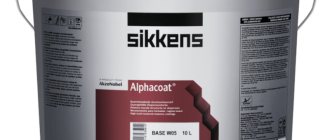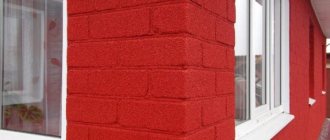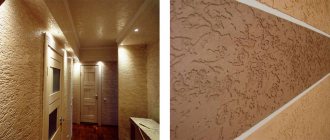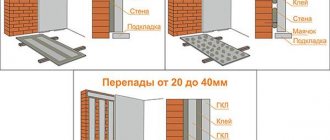Description of the material and scope of its application
Acrylic paint is a water-dispersible material based on polyacrylates, which act as film formers and are derivatives of acrylic acid. Like other water-based products, acrylic paints can be diluted, are easily tinted with water-pigment pastes, and as they dry, they acquire a certain resistance to moisture. Since the materials do not contain organic solvents, they are harmless both during application and throughout their entire service life.
Acrylic has excellent technical characteristics, which provides a wide range of its applications. Depending on additional additives, paints can be used indoors and outdoors, in painting, and for body work. Their texture is light, but after polymerization they provide a fairly durable coating that is resistant to adverse factors. The compositions do not fade under the influence of ultraviolet radiation, maintaining their bright shades. They have virtually no restrictions regarding the materials they can be applied to:
- tree;
- plaster;
- drywall;
- concrete;
- brick;
- metal.
Indoors, acrylic paints and varnishes are used to paint walls and ceilings. Many people prefer to apply them to wallpaper intended for painting. Special products are even suitable for treating water pipes, heating systems, and radiators.
Let's move on to painting work
As with any work, you can’t do without preparation; the better it is done, the easier it will be to paint. The first step is to remove all the furniture from the room. If this is not possible, then you need to place it in the center of the room and cover it. Remove all the facades of switches and sockets, if you plan to paint the ceiling, then the chandelier is also superfluous.
Old wallpaper needs to be stripped down to bare concrete or plaster, depending on what your house is built from. If, of course, you have special wallpaper pasted for painting, and you plan to paint over the old color, then in this case there is no need to peel off the wallpaper, provided that the quality of the coating is in excellent condition.
Inspection of wall quality
Smooth walls for painting
Walls for painting must be perfect, otherwise all errors after painting will be obvious. Therefore, if the surface has chips, cracks and shallow dimples, then you need to putty them. But before this process, the wall surfaces need to be rolled with a roller with a primer solution. Traces of mold or mildew were found on the walls - this should be removed or treated with an antiseptic composition. Only after this, depending on the surface defects, can the walls be plastered or puttied.
Painting can be done on a puttied surface or covered with special wallpaper. It all depends on finances and circumstances. What I mean by this is that painting a puttied surface is much cheaper than painting one covered with wallpaper. And in some cases it is necessary to putty and paste over at the same time, this is due to walls that have small cracks. For these purposes, non-woven or fiberglass wallpaper is used, as they have a large margin of safety.
Priming walls with prime
To increase the adhesion of paint to the wall, it is necessary to generously prime all working surfaces and wait until completely dry. Large areas can be rolled out with a roller, and those that are inaccessible can be covered with a brush, as a rule, these are all corners.
What tools will you need for painting?
So that you can work calmly without distractions, it is recommended to prepare all the tools in advance:
- brush – if you plan to make original drawings or paintings, you will need several brushes of different sizes;
- roller with medium length pile;
- telescopic (extendable stick) for painting high areas, including the ceiling;
- paint tray with rolling board;
- several spatulas of different sizes;
- covering oilcloth for floors and furniture;
- drill and paint stirrer.
Tools for painting
Personal protective equipment:
- workwear with long sleeves;
- respirator bandage;
- protective glasses;
- gloves.
The paint itself is not dangerous, but it will be extremely unpleasant, especially when painting the ceiling, if liquid gets into your eyes or mouth. So we come to the main topic - how to paint the ceiling with acrylic paint.
Acrylic paint composition
Acrylic acts as the base in any acrylic paintwork material, but in addition to it, it necessarily contains a number of additional components.
Binders
The base, or binding mass of the paint, is polyacrylates in the form of an aqueous dispersion, which are considered film formers. They are responsible for strong adhesion of the composition to the surface and, thanks to their strength, ensure a long service life of the coating. The higher the quality of the base, the more reliable the dried film will be, the less it will react to mechanical damage.
Fillers
The carrier for the base in this coating is water, which makes an emulsion from the acrylic polymer. The paint dries due to the evaporation of water, but this process occurs too quickly, so retarders are added to paintwork materials - substances based on glycerin or glycol.
Drying retardant for acrylic paints Sonnet
In addition to acrylic copolymers, paints may contain up to 10% auxiliary monomers. The latter can significantly influence the properties of the material, adjusting them according to a specific purpose. Thanks to such fillers, you can change:
- elasticity;
- strength;
- hardness;
- chemical resistance;
- adhesion;
- colloidal stability.
Also, paints often contain natural minerals as fillers: talc, chalk, dolomite, calcite, kaolin, mica, barite and others. Efficiency is achieved by adding crystalline fillers with high reflectivity.
Ground talc for paints and enamels
Color pigments
Pigments are needed to give a specific color to paint. Usually they are a powder, less often a paste or liquid, which is added to the main composition. Pigments also increase the covering power of paintwork materials and enhance its resistance to ultraviolet radiation and other atmospheric factors.
Pigments can be organic and inorganic, synthetic and natural. Often, inexpensive weather-resistant substances are used for the acrylic composition - oxides of chromium, iron, lead, metal sulfides. Among inorganic colors, titanium dioxide is also used, which is introduced into super-white paints and has a high refractive index of light.
Organic pigments are used less frequently. They are tinting pastes of bright color, while they are more expensive, but have less resistance to weathering. Typically, pigment particles have sizes of 300–400 microns, since they optimally fill the voids between the components of the paintwork material and are evenly distributed throughout the material.
Solvents and other additives
Organic solvents are added only to special formulations, but most acrylic paints are diluted with plain water. The liquid reduces viscosity, imparts proper density and ensures ease of application. Additional substances in acrylic paints may include:
- emulsifiers;
- surfactant;
- biocides;
- defoamers;
- stabilizers;
- preservatives;
- initiators.
Auxiliary additives change the quality, technical, and functional characteristics of the paint and give it special properties. They also provide the necessary shelf life, coating service life, composition stability, and regulate the process of film formation. For example, surfactants and emulsifiers help pigments to be better distributed in the total mass and reduce the surface tension of emulsions. Preservatives inhibit the development of microbes, mold, fungi, defoamers reduce foam formation, thickeners regulate fluidity.
Mixing order
When producing paint, an acrylic copolymer is first placed in a container, pigments and a solvent (water) are poured in. Then a strictly measured amount of stabilizing and targeted additives and fillers is added. When ready, the paint is packaged in containers, but each batch is first tested for compliance with GOST or TU.
Features of acrylic compositions
Acrylic products are considered universal, and they are very popular among users. After drying, the surface becomes matte, although there are also glossy compositions on sale that have a beautiful shine thanks to special fillers and additives. The drying time of paintwork materials varies depending on the specific brand from 20 minutes to 24 hours.
Advantages of paints
All acrylic products based on water dispersion are safe for humans, they are environmentally friendly and do not pose a risk to nature or animals. Since only non-toxic substances are used for creation, paints can be used in children's rooms, hospitals, and gardens. Other advantages of coatings:
- No pungent odor. After applying the compositions, you do not need to ventilate the room, work slowly, this does not require the use of a respirator.
- Fire safety. The materials do not contain substances that are prone to rapid combustion. Moreover, there are special acrylic paints on sale with the addition of non-flammable components that stop burning.
- Fast drying. After application, some paints dry literally before your eyes, so you won’t have to wait long before using the coating. However, when drying, you must strictly follow the manufacturer’s recommendations, because a large number of layers increases the drying time.
- Variety of shades. There are many colors of tinting pastes and dry pigments on sale; it is easy to choose a material for any interior. Using acrylic paints you can create various designs, decorative elements and patterns.
- Elasticity and hiding power. The paint spreads perfectly over the surface, covers it with a dense layer, and does not crack or crumble after drying.
- Strength and durability. Acrylic compounds do not wear out because a strong protective film is formed on their surface. Many of them can be washed and cleaned, making them easier to maintain. The highest quality coatings last up to 10–12 years.
- Optimal microclimate. The film of the material remains vapor-permeable and therefore does not disturb the microclimate of the room. Dust and dirt do not accumulate on the paint, since its pores are minimal in size.
- Versatility. The paints are suitable for completely different situations, for external and internal work, they can be combined with other coatings. In addition, acrylic is excellent for most well-known construction and finishing materials.
- Frost resistance. Acrylic easily tolerates low temperatures, so it is suitable for use outdoors or in unheated rooms. The paint will not crack due to frost for many years.
Disadvantages of acrylic
Acrylic paints have few disadvantages. When working with them, you need to observe the temperature regime: if indoors or outdoors is less than +10 degrees, it is better to postpone work. Also, the container with the product must be stored correctly: if you leave it even slightly open, the composition will quickly become unusable due to contact with air.
Advantages and disadvantages
Acrylic paints have many advantages over conventional ones:
- dry quickly;
- are used sparingly due to the water base;
- form a strong and durable coating;
- do not emit toxic substances and are safe for health;
- fireproof;
- during operation they do not require additional costs for solvents;
- until dry, they can be easily washed off from any surface.
The paint is so convenient and easy to use that it is difficult to find flaws. However, the relative difficulties include the drying speed. If you leave an open can of paint for several hours, it will become unusable. If the work is intended to last for a long time, it is better to pour the paint into a smaller container so that you have time to use it up before it dries.
During the work, you need to monitor the condition of the paint and not delay time. It is also necessary to quickly remove drops and splashes, remembering that once they dry, they can no longer be washed off.
Types of acrylic paints
Depending on the purpose and additives included in the composition, there are several types of acrylic paints. Each product has its own technical characteristics and features.
Facade
Such compositions are excellent for cladding facades, painting street structures, fences and gates, and have the necessary technical parameters. They easily tolerate temperature changes, frost, and moisture, while only the cheapest products require the subsequent application of a protective composition. Among facade paints there are those that contain organic solvents - they are durable and reliable.
Water-based compositions for outdoor use are considered more sensitive to the influence of atmospheric factors, but are strengthened with the addition of marble chips. When applying to metal, you should choose products that include rust-protecting components. To coat wooden products, antifungal additives are added to the paint. Acrylic compounds are ideal for brick, concrete, stone, plaster.
Interior
The main difference between interior paints and façade paints is their lower resistance to moisture. However, when used in dry rooms, they will not cause any trouble either: they will serve for a long time, will not wash off, will not crumble or crack, and will also retain their original shade. Due to the ease of application and low price, this option is the most popular when painting walls and ceilings, because it allows you to bring any designer’s ideas to life.
Interior paints are cheaper than facade paints, but fulfill their purpose with dignity
Acrylic compositions can also be used for painting individual areas or interior items. They are well suited for decorating wooden windows, doors, and with some paints you can even decorate mirrors and furniture, or paint pictures directly on the walls. Unlike oil-based coatings, water-dispersed ones do not cause an unpleasant odor, so they can be used in any season without ventilating the room.
Bath enamels
Acrylic-based enamels are well suited for work in the bathroom, for example, for the restoration of bathtubs. Old paint is removed manually or by sandblasting, then the surface is degreased and new material is applied. The spraying will hold tightly, will not deteriorate from water, including hot water, and will not be damaged by temperature changes. The main thing is to apply a coating of sufficient thickness (up to several millimeters) so that it is hard and durable. High-quality compositions for bathtub restoration last up to 10 years.
Automotive
Painting a car body with acrylic has been practiced for a long time, because it gives the car a more aesthetic appearance and is durable, protecting the metal from corrosion. Typically, automotive acrylic paints are more expensive and must be applied only after a special primer coat has been completed. If the technology is strictly followed, high-quality anti-corrosion protection of the body will be ensured, and the adhesion of the paintwork to the base will be enhanced.
Acrylic car paints come in two types:
- basic - play the role of a base, helping subsequent layers to lie more evenly;
- decorative - perform an aesthetic function and thicken the coating, making it more resistant to aggressive factors.
Typically, when painting a body, one base coat and at least two decorative layers are applied - this ensures the proper thickness and strength of the paint film.
Nail compositions
Special acrylic paints are well suited for decorating nails, so they are often used when rendering. Manicure using acrylic guarantees an unusual design. Acrylic compositions dry quickly, lay down smoothly, without drips, and are easy to wipe off before hardening to create a new, more successful decor. With the help of thin brushes, the most complex patterns are drawn with acrylic, using both translucent and matte paints. Manicurists also have thick pastes for covering the previous layer, which completely hide nail polish of even the darkest color.
Paints for painting
Compared to gouache and watercolors, acrylic paints apply much denser and look more attractive and brighter. These properties are due to their texture, richness of pigments and variety of tones. Using acrylic, you can make three-dimensional pictures by layering one on top of another.
Other advantages of acrylic for creativity:
- hypoallergenic, completely safe for children;
- the ability to wash off if applied incorrectly;
- drawing on paper, cardboard, fabric, canvas, glass - any base will do;
- application in different styles, artistic techniques;
- long service life without cracks, yellowing;
- no fading from sunlight;
- moisture resistance, the ability to carefully wipe off dust.
Material advantage
Compared to oil compositions, acrylic ones have a number of technological advantages:
- They dry quickly (one to two hours is enough), and can be applied even to a slightly damp surface . Quick-drying compositions have also been developed, which require 30 minutes to dry completely. This makes it possible to speed up the work process when finishing the interior.
Interior latex acrylic paint
- After drying, the material, unlike oil paints, does not fade in the sun or fade, and retains its original color for a long time . The treated surface retains natural ventilation, i.e. it “breathes”, so they are ideal for painting the facade and interior of wooden buildings.
- The quality of the finishing layer can only be assessed after it has completely dried . In this case, cracks and various deformations do not occur, which is typical for oil analogues. The material can withstand small temperature changes.
- Acrylic paints are not difficult to work with . For example, residues from tools can be easily removed with plain water without the use of chemical solvents.
Compositions for treating walls outside
Paint that gets onto unwanted areas can be removed without damaging the already painted surface. During the dyeing process, no toxic substances are released into the air; as it dries, water evaporates.
In addition, the price of this group of paints is lower than oil-based materials, which also adds to their attractiveness among consumers. They are produced in cans (volume 0.5-4 l) and tubes (60-200 ml). The first are intended for construction work, the second for artists.
Recommendations for application
Before you paint with acrylic, you must understand that the technology of painting with water-dispersion paints is directly related to the surface being treated and the result that you want to get in the end.
They can be applied in different ways, and it depends on the complexity of the work.
However, there are recommendations on how to properly paint with acrylic paint, which must be followed regardless:
- Dilute acrylic paints either with water or solutions specially developed by manufacturers.
- Do not add solution or water directly to the paint container. Use a separate container for dilution, into which you first pour the required amount of the composition.
Water-based mixture for facade work
Tip: It’s better to dilute a small amount of paint several times than to dilute all of it at once. Otherwise, after the water evaporates, the material will simply dry out and be damaged.
- Before sealing a paint can so it can be used again, thoroughly clean the area where the can and lid come into contact. If you don't do this, the remaining paint may dry out so much that it will no longer be possible to open the can.
- After finishing working with acrylic paints, immediately rinse the tools with water. Then you can quickly clean them and use them in the future; after the paint has dried, this will be much more difficult.
- Work only with specially pre-prepared paint. Depending on the complexity and type of work, it should be diluted with water or a special solution, and maybe even thickened to a paste. Thanks to this preliminary preparation, acrylic water-dispersed or water-based paints have good adhesion to the base, allowing them to work even in difficult weather conditions.
We recommend: Arranging and assembling a paint booth with your own hands
Solutions used for dilution are divided into two types:
- for a matte shade;
- for shiny.
Tip: if you decide to do wall painting, you must know these properties of the materials.
Application
So, what can you paint with acrylic paints yourself?
Below are three surfaces most often encountered in repairs:
- Painting non-woven wallpaper with acrylic paint yourself requires some skill. If you don’t have enough of it, use the simplest method - choose wallpaper with a repeating pattern and a uniform structure.
Painting non-woven wallpaper with an acrylic mixture
For work, prepare tools, the better to apply acrylic paint specifically for you, for example, a roller, brush or paint sprayer to paint the outer layer. A more complex method involves painting from the inside or wiping off the paint after application.
Whatever method you use and regardless of your skill, follow two rules:
- use only water-based paints without adding impurities harmful to humans;
- Before the process, take a small piece and do a test painting, so you can see the final result with your own eyes.
- Acrylic paints and plaster. In this case, the features of the latter should be taken into account. The surface must be dry, clean and level, old paint must be removed in advance.
Advice: pay special attention to sealing cracks, and the plaster before painting should be polished with fine sandpaper.
We paint the plaster ourselves
So how to apply acrylic paint? This should be done on a primed surface before painting in one direction.
Use some recommendations to get the desired result:
- Tape the ceiling and adjacent walls in the corners with masking tape so as not to stain adjacent surfaces. Thus, you will not need to rush to remove the paint from them later;
- choose the right tool for the job. The roller, for example, should have long pile. This will help speed up the work process and apply the material more evenly to the surface;
- dilute the paint for the roller in a wide special container; it should also have a corrugated surface to remove excess paint.
- The use of acrylic paints for concrete surfaces allows them to be protected from damage, wear and dust. In addition, application of the material allows:
- give it an aesthetic appearance;
- improve performance characteristics;
- protect from chemicals.
Like any other material, acrylic paint is applied to concrete according to technical instructions and recommendations. The surface must first be cleaned of dirt, dusted, washed with water and dried, but priming is not necessary. The instructions allow you to apply the material even at sub-zero temperatures, which sets it apart from others.
Painting concrete with acrylic
Water-based acrylic paints are also used for concrete. Their main positive characteristics are non-toxicity and fire resistance. In addition, they are resistant to alkaline solutions.
Other material classifications
Depending on the properties and drying method, acrylic paints can be grouped as follows:
- cold-drying compositions (based on thermoplastic polymers);
- hot-dry coatings (consist of thermoactive polymers);
- water-emulsion paints of natural drying.
Based on their specific qualities, paints are divided into waterproof, washable, weatherproof, and lightfast. You need to select a specific type based on the tasks and type of room in which they will be used. Many formulations are considered universal, as indicated by the manufacturer on the packaging. Other paints, on the contrary, are intended for a specific type of material, and the manufacturer also warns about this (for metal, wood, concrete). In appearance, acrylic compositions are:
- matte;
- glossy;
- semi-gloss;
- semi-matte;
- silky with a matte base.
They all look beautiful, so you need to choose according to the design idea in a particular room.
Selection of acrylic paints
To purchase, you should visit a construction supermarket or another store that sells trustworthy brands of paint and varnish products. This will eliminate the purchase of a low-quality fake, which may not contain acrylic at all. If paint is purchased for walls or ceilings in a damp room, you should pay attention to its resistance to moisture and the presence of antiseptic additives in the composition.
Each can of paint always indicates the permissible number of brushing treatments (indicated by numbers). The manufacturer guarantees no damage until this indicator is reached (usually it is no more than 30). The shelf life of the saturated color, which does not differ from the original in intensity, is also indicated on the label - in years or months.
Indoor ceilings are most often painted white. When purchasing such paint, you need to be more careful: often the mark “white” does not correspond to reality, and in reality the material is milky or yellowish. The ideal shade can only be achieved by applying super white paint.
When purchasing, it is also important to evaluate the level of paint viscosity. Mixtures that are too viscous are difficult to work with, especially with a spray gun. They will have to be diluted, which is quite labor-intensive when processing large areas. Watery paint is also not the best solution; it does not have sufficient adhesion and hiding power, so the quality of wall painting will remain at a low level.
According to professionals, the most convenient and high-quality products are those with the addition of thixotropic substances. Thanks to them, the paint does not flow down the wall or drip from the tools, but its consistency becomes optimal when mixed. After drying, such compositions form a perfectly smooth polymer film on surfaces.
Paints for wet areas
In the kitchen, bathroom or other wet areas, use acrylic paint marked “washable”. It has moisture-repellent properties, and products with the additional introduction of latex also do not allow steam to pass through and are not afraid of thermal stress, so they are well suited for arranging kitchen aprons and bathroom walls. Since moisture-resistant paints are more resistant to mechanical damage, they can be used where walls have to be washed frequently.
Ceiling paints
To treat the ceiling, you can buy regular acrylic paint in white or super white. As a rule, the can is marked “for ceilings” or “for walls and ceilings.” If desired, colored paste colors of the desired shade are introduced into such paints, allowing you to give an unusual look.
Matte and glossy compositions
When choosing between gloss and matte surfaces, you need to be guided by the design of the room and personal preferences. Matte textures visually smooth out uneven walls and make the room more formal but stylish. Glossy compounds emphasize all bulges, so the walls must be smooth and well prepared.
Using glossy paint on the ceiling, on the contrary, will be a very successful design option. Such paintwork will add shine, visually increase the dimensions of the room, and fill it with space. When purchasing, you should also remember about the drying time of paints: usually glossy paints dry much faster than matte paints (in just 30–40 minutes).
Acrylic compounds have good hiding power
General information
Acrylic paints are created on the basis of polyacrylic emulsion, soluble in water. After drying, they form a coating with excellent performance and aesthetic properties.
Thus, surfaces painted with acrylic paint have the following properties:
- retain the brightness of the coating for at least 12 years ;
- are not affected by water or any other solvents except special ones
- do not burn and do not emit harmful substances when heated;
- more durable compared to any other paints.
Acrylic paint is pleasant and convenient to use:
- it has no smell;
- stains and drops that have not had time to dry are easily washed off, leaving no traces;
- the coating dries quickly.
- The paint is completely safe and can be used for any premises, including children's rooms.
How to thin the material
Paint that is too thick must be thinned. Water, which is included in all acrylic paints, should be used as a solvent. You can also use special products for dilution, which are sold in stores: they can only be a solvent or additionally impart special effects (gloss, glitter, metallic).
When adding water, it is important to maintain the correct proportions so as not to spoil the paint. The best option is to dilute the material with water 1:1 if the product in the jar is very thick. This mixture will cover the walls with a dense layer without gaps and will maintain good coverage.
You can use diluted paint as a base, and apply another, but thinner layer on top, diluting the material in a 1:2 ratio. Liquid paint can also be used to cosmetically update walls: the composition will cover minor dirt, wash away dust, and remove stains.
It happens that acrylic paintwork dries out greatly and becomes completely unusable. Some try to dilute it, but such actions lead to the opposite effect - the material comes out in lumps and becomes heterogeneous. It is necessary to completely dry the acrylic, grind it to a powder, and only then dilute it with cold boiled water. The quality characteristics of such paint will be worse than those of the original mass, moreover, the drying and crushing procedure is labor-intensive and time-consuming. Therefore, it is recommended to purchase a new acrylic composition, which is easy to work with and the result will be at a high level.
Tips for applying paint
To work, you need to prepare brushes, rollers, a paint container and, if necessary, a stepladder. First, the walls are leveled, after removing the old peeling coating. The last layer should be a well-polished white finishing putty. Initially, smooth walls just need to be cleaned of dust, dirt, and degreased. Immediately before painting, the base is primed with 1-2 layers - this will reduce absorption, paint consumption, and increase adhesion and evenness of its application.
Coloring begins from the corners. Having painted the perimeter of the walls well with a brush or roller, move on to the central part. It is recommended to make movements horizontally in the direction of the window - this will help make the coating more uniform. Usually 3 layers are applied, but if the surface is slightly contaminated, two are sufficient.
Professionals often work with acrylic compounds using a spray gun. At home, you can use a roller, and in hard-to-reach areas and corners - a comfortable brush with durable bristles that will not fall out. Acrylic dries quickly, so finishing work must be done at an accelerated pace, otherwise streaks will remain on the wall or ceiling.
Material packaging
Acrylic compositions are sold in containers of different sizes and types. Nail products are sold in jars of 20–100 ml, painting materials are sold in tubes, bottles, and jars of 50–150 ml. Interior and facade paints are presented in containers from 1 liter to 50 liters, depending on the manufacturer. For industrial purposes, large-volume barrels (up to 100–150 l) are purchased.
VDAK-449
This paint is used only for painting floors and some other concrete and wood surfaces. It has a pleasant color and no smell. The coating is fireproof, durable and wear-resistant. It is typically used for basements and utility rooms in residential areas where there is no high humidity. The paint characteristics are as follows:
- The final coating is uniform or semi-matte.
- The color may be red-brown or yellow-brown.
- When properly coated, it can last up to five years.
- Paint consumption is 200-250 grams per square meter.
- It takes about an hour for the coating to dry completely.
- The dye can be diluted with water up to 10%.
In the future, the coating can be easily washed with ordinary water, but this must take at least two weeks from the date of application. For processing you can use a brush or roller. It is not recommended to use paint at temperatures less than five degrees and humidity levels greater than 80%.
Color spectrum
The shades of acrylic compositions are very diverse. Colors can be classic and unusual: with mother-of-pearl, sparkles, metallic, fluorescence. Among the matte tones you can find simple and original, bright and pastel. In various interior styles, bronze, gold, and silver paints are considered popular.
The basic ones are white and beige compositions. Snow-white paint is easily tinted, and most large supermarkets offer a tinting service. You can choose any suitable color from the proposed catalog and get the finished composition in just 5 minutes. Recommendations for choosing a shade are as follows:
- for the bedroom you should give preference to calm, soothing tones;
- for the living room you can choose brighter shades;
- It is better to decorate the kitchen in a laconic cool tone;
- Juicy colors are great for children: green, orange, yellow;
- in high-tech and techno styles, you can use black and dark blue glossy paint options, combining them with white and silver compositions.
The color range of acrylic paints is limitless
Popular manufacturers
Acrylic paints and varnishes are produced by almost all companies that make paint and varnish products. Below are the brands that you can buy without fear, as their quality has been tested by time.
Dulux
A world-famous manufacturer that regularly produces new acrylic, latex and other compounds. High quality materials are combined with a reasonable price. Paints of this brand have different technical characteristics: texture, resistance to external influences, moisture tolerance. From the company's catalog it is easy to choose the appropriate option for any room.
Tikkurila
Another popular brand that presents the widest selection of various paints and varnishes on the market. Tikkurila is famous for the very high quality of its products, but its price may be higher than that of its analogues. Most acrylic compounds are universal. There is also a separate line of acrylic-based products for baths and saunas.
Belinka
The paints of this brand are famous for their durability and wear resistance. There are universal products, as well as separate materials for walls, ceilings, wet rooms, and facade paints. Many products are designed to withstand regular mechanical and physical stress and aggressive chemicals.
Caparol
A German brand that consistently guarantees quality and long service life of coatings. During its existence (more than 120 years), the company has gained worldwide popularity and recognition. All products are positioned as environmentally friendly, harmless to humans and the environment.
Litokol
The company produces high-quality polymer-based interior and façade paints that are stain-resistant and have excellent water-repellent properties. There is a line of products for painting decorative plasters and other building mineral bases, which include a patented protective system. All products are produced using the latest technologies, do not fade, and are not afraid of fungus.
Farbitex
Acrylic compounds of this brand are intended for working on concrete, brick, chipboard and fiberboard, wood, and are suitable for painting wallpaper. The products are universal in terms of the premises in which they can be used. They are suitable for application to walls and ceilings in living rooms, halls and halls, corridors, and other actively used rooms.
Ceresit
This brand produces various paints and varnishes for exterior and interior use. Most paints have the following properties:
- made on a water-dispersion basis;
- white, subject to tinting;
- vapor permeable;
- alkali-resistant;
- weatherproof;
- environmentally friendly.
ALPINA
This brand produces two product lines: for home use and professional. All compositions are easy to apply and have high quality characteristics. In addition to them, a variety of tinting pastes, pigments, and glazes are produced. ALPINA paints are divided into those intended for interior use, as well as products for exterior use. There are separate lines of waterproof compositions for the bathroom, bathhouse, and sauna.
VGT
The company structure includes several laboratories and a research center, where the quality of products is controlled and new types are constantly developed. When producing paint and varnish products, the climatic characteristics of the regions are taken into account, the requirements of environmental friendliness, color purity, and moderate cost are met. The paint is packaged in containers of 1–45 kg.
"Tex"
Acrylic compositions of this brand, as well as acrylic-latex paints, are very resistant to external factors, dense, and have good hiding power. Most materials are universal, and at the same time they perfectly protect the base from rusting, rotting, and mold.
The use of acrylic paints greatly facilitates DIY home renovations. They are easy to apply, do not have an unpleasant odor, are evenly distributed over the surface and invariably give excellent results even without the user having the proper experience.

